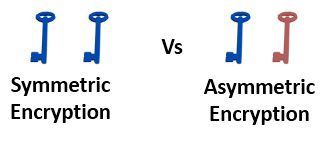 While communicating on an unsecured medium like the internet, you have to be careful about the confidentiality of the information you are sharing with other. The are two techniques use to preserve the confidentiality of your message, Symmetric and Asymmetric Encryption. The fundamental difference that distinguishes symmetric and asymmetric encryption is that symmetric encryption allows encryption and decryption of the message with the same key.
While communicating on an unsecured medium like the internet, you have to be careful about the confidentiality of the information you are sharing with other. The are two techniques use to preserve the confidentiality of your message, Symmetric and Asymmetric Encryption. The fundamental difference that distinguishes symmetric and asymmetric encryption is that symmetric encryption allows encryption and decryption of the message with the same key.
On the other hand, asymmetric encryption uses the public key for the encryption, and a private key is used for decryption. To acknowledge some more differences between symmetric and asymmetric encryption have a look at the comparison chart shown below.
Content: Symmetric Encryption Vs Asymmetric Encryption
Comparison Chart
| Basis for Comparison | Symmetric Encryption | Asymmetric Encryption |
|---|---|---|
| Basic | Symmetric encryption uses a single key for both encryption and Decryption. | Asymmetric encryption uses a different key for encryption and decryption. |
| Performance | Symmetric encryption is fast in execution. | Asymmetric Encryption is slow in execution due to the high computational burden. |
| Algorithms | DES, 3DES, AES, and RC4. | Diffie-Hellman, RSA. |
| Purpose | The symmetric encryption is used for bulk data transmission. | The asymmetric encryption is often used for securely exchanging secret keys. |
Definition of Symmetric Encryption
Symmetric encryption is a technique which allows the use of only one key for performing both the encryption and the decryption of the message shared over the internet. It is also known as the conventional method used for encryption.
In symmetric encryption, the plaintext is encrypted and is converted to the ciphertext using a key and an encryption algorithm. While the cipher text is converted back to plain text using the same key that was used for encryption, and the decryption algorithm. Symmetric encryption algorithm executes faster and is less complex hence; they are used for bulk data transmission.
 In symmetric encryption, the host that are participating in the communication already have the secret key that is received through the external means. The sender of the message or information will use the key for encrypting the message, and the receiver will use the key for decrypting the message. The commonly used symmetric encryption algorithms are DES, 3 DES, AES, RC4.
In symmetric encryption, the host that are participating in the communication already have the secret key that is received through the external means. The sender of the message or information will use the key for encrypting the message, and the receiver will use the key for decrypting the message. The commonly used symmetric encryption algorithms are DES, 3 DES, AES, RC4.
Definition of Asymmetric Encryption
Asymmetric encryption is an encryption technique that uses a pair of key (private key and public key) for encryption and decryption. Asymmetric encryption uses the public key for the encryption of the message and the private key for the decryption of the message.
The public key is freely available to anyone who is interested in sending the message. The private key is kept secret with the receiver of the message. Any message that is encrypted by the public key and the algorithm, is decrypted using the same the algorithm and the matching private key of corresponding public key.
 The asymmetric encryption algorithm execution is slow. As asymmetric encryption algorithm are complex in nature and have the high computational burden. Hence, the asymmetric encryption is used for securely exchanging the keys instead of the bulk data transmission.
The asymmetric encryption algorithm execution is slow. As asymmetric encryption algorithm are complex in nature and have the high computational burden. Hence, the asymmetric encryption is used for securely exchanging the keys instead of the bulk data transmission.
Asymmetric encryption is generally used for establishing a secure channel over the non-secure medium like the internet. The most common asymmetric encryption algorithm are Diffie-Hellman and RSA algorithm.
Key Differences Between Symmetric and Asymmetric Encryption
- Symmetric encryption always uses a single key for encryption and decryption of the message. However, in asymmetric encryption, the sender uses the public key for the encryption and private key for decryption.
- The execution of asymmetric encryption algorithms is slower as compared to the symmetric encryption algorithm. This is because the asymmetric encryption algorithms are more complex and have a high computational burden.
- The symmetric encryption algorithms that are most commonly used are DES, 3DES, AES and RC4. On the other hand, Diffie-Hellman and RSA area the most common algorithm used for asymmetric encryption.
- The asymmetric encryption is generally used for exchanging secret keys whereas, the symmetric encryption is used for exchanging a bulk of data.
Conclusion
Being a complex and slow encryption technique the asymmetric encryption is generally used for exchanging the keys and the symmetric encryption being a faster technique is used for bulk data transmission.
Bruce says
Awesome